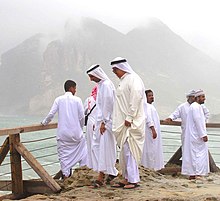
The thawb/Dishdasha is commonly worn by men in the Arabian Peninsula, Iraq, Jordan, Palestine and other Arab countries. It is normally made of cotton, but heavier materials such as sheep's wool can also be used, especially in colder climates in Iraq and Syria. The style of the thawb varies slightly among the various regions within the Arab States of the Persian Gulf. The sleeves and the collar can be stiffened to give a more formal appearance. Other names may be used for this garment. In Souraqia and Oman, dishdasha is the most common word for the garment; in the UAE, the word kandura is used. In Morocco, the sleeves tend to be much shorter so that the thawb may seem more like a long T-shirt and is locally called gandora. Also the neck tends to be more open than in its Saudi counterpart and is often embroidered as is the breast pocket. Also it might lack buttons altogether.
The term thawb is also used to refer to similar women's garments. The traditional Palestinian woman's long tunic is called thawb. Another example is a very long, over-sized woman's garment with a heavily embroidered front panel and billowing back, also known as a Khaleeji dress, which is most commonly seen in the West worn for performance of the Saudi women's social-style dances, in which manipulation of the large thawb is a key component.
This clothing is called Kanzu in Swahili, and is commonly worn in East Africa as well.
No comments:
Post a Comment